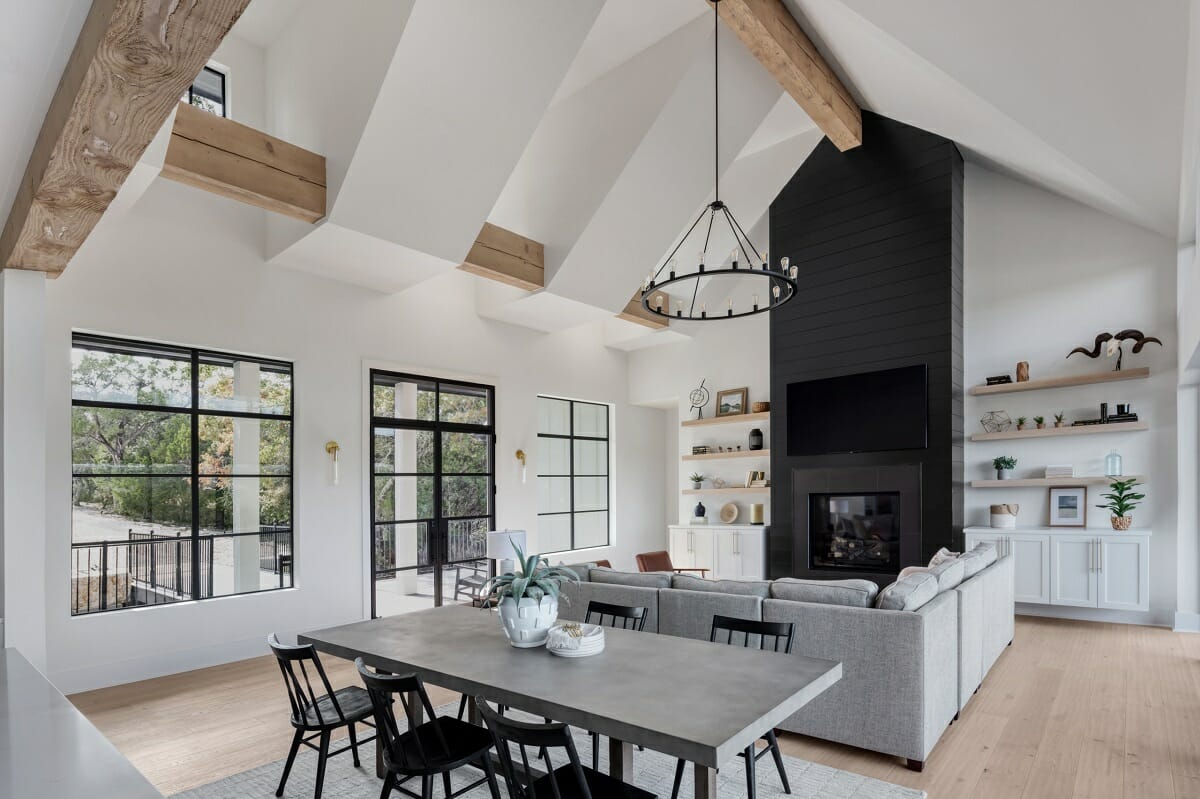The Craftsman bungalow house design was popular in the early 1920s. These homes are typically one-story, one-and-a-half-story, or two-story with a covered porch and a detached garage in the rear. The exteriors typically feature an asymmetrical façade with a low-slung roof and tapered columns. Inside, the interiors feature natural materials such as hardwood floors, built-in cabinets, and wood finishes throughout. 1920s Craftsman Bungalow House Design
The Mediterranean Revival house design was popular in the early 1920s and is still popular today. These homes are typically one- or two-stories with a stucco wall-style exterior, arched doorways, tiled roofs, and a low-slung hip roof. Inside, it features rustic elements such as stone floors, exposed beams, and vaulted ceilings. 1920s Mediterranean Revival House Design
The Colonial Revival house design was popular in the early 1920s and is still popular today. This style typically features a symmetrical façade with a low-slung roof and classical details such as columns, brackets, and dentil moldings. Inside the home, circa-appropriate finishes are often paired with modern updates for a timeless design. 1920s Colonial Revival House Design
The Spanish Revival house design is one of the most popular styles of the 1920s. The exteriors of these homes are typically one- or two-story with a stucco finish and low-slung, terra-cotta tile roofs. Inside, it can feature exposed wood beams, an open floor plan, and hand-painted, bright accents including tile, paintings, and wrought iron detailing. 1920s Spanish Revival House Design
Four Square house designs were popular in the early 1920s and they often feature an L-shaped floor plan, symmetrical façade, a low-pitched roof, and an open porch. It is distinguished from other styles by its boxy shape and lack of ornamentation. The interiors often feature dark wood finishes, built-in cabinetry, and arched doorways. 1920s Four Square House Design
The Tudor Revival house was introduced in the early 1920s and it is characterized by its steeply-pitched, half-timbered façade and asymmetrical lines. These homes often feature an open porch, a wide front door, and leaded glass windows. Inside, it typically features dark wood trim, built-in cabinets, and flowered wallpaper. 1920s Tudor Revival House Design
The Gothic Revival house was introduced in the early 1920s and it often features an asymmetrical façade with a gabled roof and decorative crenellations along the roofline. It also has an open porch, large windows, and pointed arches. Inside, it typically features dark wood finishes, an open staircase, and stained glass windows. 1920s Gothic Revival House Design
The Dutch Colonial Revival house was introduced in the early 1920s and it is characterized by its steeply-pitched, one-and-a-half-story roof, overhanging eaves, and clipped gables. It also often has an open porch or balcony on the second story. Inside, it typically features wood floors, a large central fireplace, and built-in cabinets. 1920s Dutch Colonial Revival House Design
The Italian Renaissance Revival house was introduced in the early 1920s and it is characterized by its distinctive façade with a curved pediment, a low-slung hip roof, and ornate columns. Inside, it typically features marble floors, fresco ceilings, and sweeping staircases. 1920s Italian Renaissance Revival House Design
The Queen Anne Cottage house was introduced in the early 1920s and it often features an asymmetrical façade with a steeply pitched roof, a wrap-around porch, and Tudor-inspired elements such as half-timber detailing and diamond-pane windows. Inside, it typically features dark wood floors, built-in cabinets, and grand staircases. 1920s Queen Anne Cottage House Design
The Stick Style house was introduced in the early 1920s and it is characterized by its vertical exterior and gabled roof. It typically features an asymmetrical façade, large windows, and intricate details such as a wide front porch, decorative spindles, and clapboard siding. Inside, it typically features wood floors, an open floor plan, and an ornate staircase. 1920s Stick Style House Design
Identifiable Characteristics of a Typical 1920s House Plan
 The wide variety of house plans and fashions of the 1920s adolescence was characterized by a spirit of enthusiasm and optimism. A typical 1920s house plan encompassed the popular "American dream" during the period, complete with a moderate roof pitch, wide eaves, and a front porch. The narrow width of the floor plan made these
typical 1920s house plans
a practical option for those who were constructing their dream home on a smaller lot of land.
The room configuration for a typical 1920s house plan usually included a formal dining room, unusually located next to the kitchen; a central staircase with a landing as a central focal point of the house plan; a living room, typically with a fireplace; and multiple bedrooms located upstairs or on the main floor. Many of these homes contained built-in cabinetry, a convenient nook or breakfast room within the kitchen, and hardwood floors throughout. Floor plans for these homes were it was largely standardized, featuring square or rectangular shapes as opposed to more modern, unique floor plan designs.
The wide variety of house plans and fashions of the 1920s adolescence was characterized by a spirit of enthusiasm and optimism. A typical 1920s house plan encompassed the popular "American dream" during the period, complete with a moderate roof pitch, wide eaves, and a front porch. The narrow width of the floor plan made these
typical 1920s house plans
a practical option for those who were constructing their dream home on a smaller lot of land.
The room configuration for a typical 1920s house plan usually included a formal dining room, unusually located next to the kitchen; a central staircase with a landing as a central focal point of the house plan; a living room, typically with a fireplace; and multiple bedrooms located upstairs or on the main floor. Many of these homes contained built-in cabinetry, a convenient nook or breakfast room within the kitchen, and hardwood floors throughout. Floor plans for these homes were it was largely standardized, featuring square or rectangular shapes as opposed to more modern, unique floor plan designs.
Symmetrical Exterior
 Exteriors of a
typical 1920s house plan
featured symmetrical shapes that highlighted the architectural trends of the time. Complementary divided-light windows were common, along with most homes featuring a central entryway with a window on each side. A large front porch and multi-paned casement windows were also prevalent during this time period. The brick façade and decorative accents common to the 1920s were still prevalent and in many cases are still in use today.
Exteriors of a
typical 1920s house plan
featured symmetrical shapes that highlighted the architectural trends of the time. Complementary divided-light windows were common, along with most homes featuring a central entryway with a window on each side. A large front porch and multi-paned casement windows were also prevalent during this time period. The brick façade and decorative accents common to the 1920s were still prevalent and in many cases are still in use today.
Bungalow Experience of the 1920s
 In the early 1920s, in the United States, the "California style" bungalow, with its large living rooms, was gaining in popularity across America. Craftsman-style bungalows with large front porches and gabled roofs featured elements of Georgian, Colonial Revival, and Tudor styles. During this period, popular interior features included beautiful oak flooring, built-in bookcases, and large mantelpieces with copper finishes. Many of these homes also contained side porches, patterned shingles, and large windows to let in natural light. As most houses of this period had no air conditioning, large porches and transoms helped to keep homes cool during the hot summer months.
In the early 1920s, in the United States, the "California style" bungalow, with its large living rooms, was gaining in popularity across America. Craftsman-style bungalows with large front porches and gabled roofs featured elements of Georgian, Colonial Revival, and Tudor styles. During this period, popular interior features included beautiful oak flooring, built-in bookcases, and large mantelpieces with copper finishes. Many of these homes also contained side porches, patterned shingles, and large windows to let in natural light. As most houses of this period had no air conditioning, large porches and transoms helped to keep homes cool during the hot summer months.
The Return to Luxury
 As the 1920s drew to a close, a new wave of luxury homes rose in popularity. These homes typically featured larger floor plans and ornate touches that spoke of the affluence of the period. Decorative touches included the use of magnificently tiled entryways, ornately carved mantelpieces, and elaborate fireplaces. These houses also featured multi-paned glass windows, brickwork, and multiple levels in their floor plans. While most homes during this period featured natural materials such as stone and stucco, it was not uncommon to see design touches of marble, intricate tilework, and more streamlined glass panes.
As the 1920s drew to a close, a new wave of luxury homes rose in popularity. These homes typically featured larger floor plans and ornate touches that spoke of the affluence of the period. Decorative touches included the use of magnificently tiled entryways, ornately carved mantelpieces, and elaborate fireplaces. These houses also featured multi-paned glass windows, brickwork, and multiple levels in their floor plans. While most homes during this period featured natural materials such as stone and stucco, it was not uncommon to see design touches of marble, intricate tilework, and more streamlined glass panes.



































































































